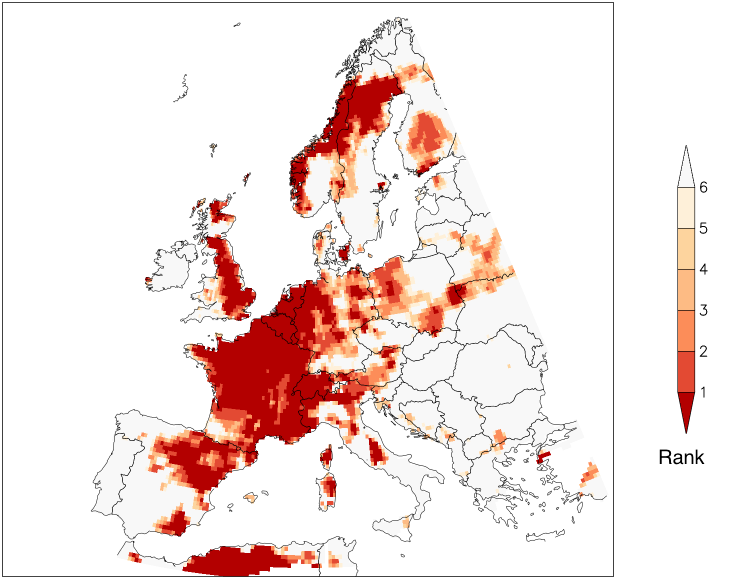In June, new all-time records were set in multiple places across Western Europe. In July, records were broken again, albeit in different areas. Again, the role of climate change in producing such high-amplitude events was questioned.

This study assesses how human-induced climate change has altered the likelihood and intensity of the July event or similar events. It uses a large number of climate simulations that were available at the time of study (8 ensembles of 10 to over 100 simulations each). We define the event as the class of events exceeding the observed values of daily mean temperatures averaged over 3 days for a few locations in Western Europe. Three days in a row of high temperatures are often considered as the minimal length for a hot spell to have potential health impacts.
We combined information from both long series of observations and climate model simulations in order to obtain best estimates of changes in probability and intensity of an event like (or more severe than) the observed July extreme temperatures in Western Europe attributable to human-induced climate change. The few observation sites were selected to both include a large July heat wave signature and have long and homogeneous enough records with least perturbations from urban heat island effects. We used statistical models of extremes such as the Generalized Extreme Values model, and applied them to both observations and simulations. This allows us to assess (i) models’ skill to simulate extremes and (ii) how climate change altered the odds of extremes. Models that did not represent heat waves well were withdrawn from the analysis.
Key findings
- A second record-breaking heat wave of 3-4 days took place in Western Europe in the last week of July 2019, with temperatures exceeding 40 degrees in many countries including Belgium and the Netherlands where temperatures above 40°C were recorded for the first time. In the U.K. the event was shorter lived (1-2 days), yet a new historical daily maximum temperature was recorded exceeding the previous record set during the hazardous August 2003 heatwave.
- In contrast to other heat waves that have been attributed in Western Europe before, this July heat was also a rare event in today’s climate in France and the Netherlands. There, the observed temperatures, averaged over 3 days, were estimated to have a 50-year to 150-year return period in the current climate. Note that return periods of temperatures vary between different measures and locations are therefore highly uncertain.
- Combining information from models and observations, we find that such heatwaves in France and the Netherlands would have had return periods that are about a hundred times higher (at least 10 times) without climate change. Over France and the Netherlands, such temperatures would have had extremely little chance to occur without human influence on climate (return periods higher than ~1000 years).
- In the U.K. and Germany, the event is less rare (estimated return periods around 10-30 years in the current climate) and the likelihood is about 10 times higher (at least 3 times) due to climate change. Such an event would have had return periods of from a few tens to a few hundreds of years without climate change.
- In all locations an event like the observed would have been 1.5 to 3 ºC cooler in an unchanged climate.
- As for the June heatwave, we found that climate models have systematic biases in representing heat waves at these time scales and they show about 50% smaller trends than observations in this part of Europe and much higher year-to-year variability than the observations. Despite this, models still simulate very large probability changes.
- Heatwaves during the height of summer pose a substantial risk to human health and are potentially lethal. This risk is aggravated by climate change, but also by other factors such as an aging population, urbanisation, changing social structures, and levels of preparedness. The full impact is only known after a few weeks when the mortality figures have been analysed. Effective heat emergency plans, together with accurate weather forecasts such as those issued before this heatwave, reduce impacts and are becoming even more important in light of the rising risks.
- It is noteworthy that every heatwave analysed so far in Europe in recent years (2003, 2010, 2015, 2017, 2018, June 2019, this study) was found to be made much more likely and more intense due to human-induced climate change. How much more depends very strongly on the event definition: location, season, intensity and duration. The July 2019 heatwave was so extreme over continental Western Europe that the observed magnitudes would have been extremely unlikely without climate change.
Read the full report (pdf, 1.7 MB).





